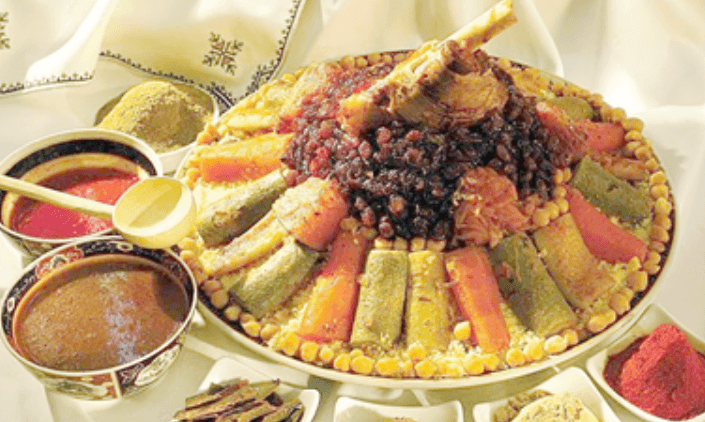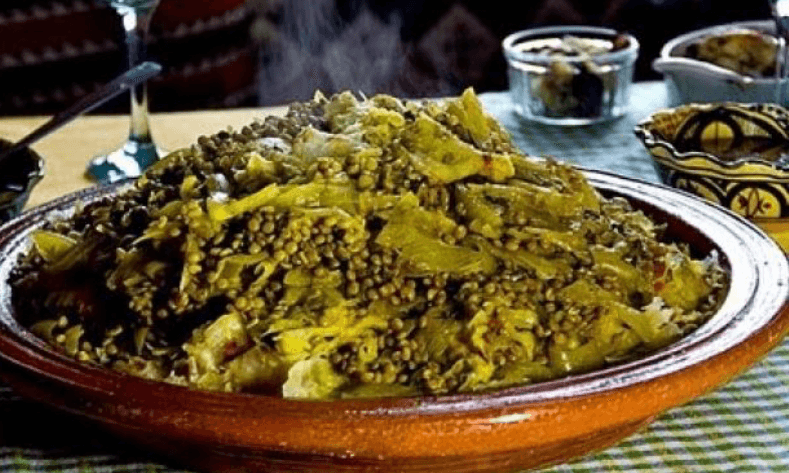
Moroccan food was able to win the satisfaction of countless individuals, thanks to the variety of its dishes, whether it relates to tagine, Couscous, Bastilla or Rfisa.

Moroccan food outperformed famous global foods such as Italian and Japanese food in the vote, reaching the last with Mexican cuisine, to win the race in its support by obtaining 60 percent of the ballot.
Moroccan food won starting point in the individuals’ ballot, as it obtained 2.5 million ballots, to be crowned the very best cuisine in the world.
Moroccan food brushed up the outcomes of a survey released by the world’s most renowned chefs, about the best global foods, as the popular British cook Gordon Ramsay monitored an online poll to vote on the very best and most tasty dishes.
The Reason Why Moroccan Food Gained World Prominence
What created this amazing triumph? Another world poll organized very recently by Pubity saw 2.5 million ardent food men and women, and the majority voted for Moroccan cuisine which fared better than other runner-ups such as Mexican cuisine . That drive was provided by the social media campaigns and the active support of Moroccan communities across the globe.
The Seal of Approval by the Culinary Presidents
The result was announced by a world-known chef Gordon Ramsay, who celebrated the sophistication and intricacy of Moroccan cuisine . The fact that he endorsed the win gave it some standing among the world gourmet faithful.
Why is the Moroccan Food Top?
Spices is Singing
Moroccan food is extremely skillful in terms of the use of spices, such as saffron, cumin, cinnamon, turmeric and the legendary ras el hanout – a mixture of three dozens spices, which introduces a unique palette of flavor in every dish . Whether combing sweet and savory chicken pastilla or robust lamb tagine, stewed with prunes and rosemary, the seasoning has always been stratified and harmonized.
Sweet and Savory
Such dishes as Pastilla (flaky pie with almonds and cinnamon) and Rfissa (chicken with lentils and fenugreek) express the renowned sweet and savory contrast. The outcome is a well-balanced cuisine that appeals to the palate in a surprise manner.
Abundance of the Land and Sea
Moroccan landscape grows an abundant range of foodstuffs, including olive oil, preserved lemons, dates, fish, lamb, and vegetables, and right down to Atlantic Coast fisheries. Both biodiversity and tradition are reflected in the coexistence of coastal foods such as the grilled sardines with stews of the interior.
Local Dishes to Expose
Marrakesh cuisine
The legendary tanjia marrakshia (a slow-cooked lamb stew in embers and spices) of Marrakesh exists. It is left to boil in a pot of clay (or tanjia) with smen (aged butter) cooked in it and blended with ras el hanout to generate a dish with so much depth and smoky aroma .
Harira Bissara soul food
Harira (lentil-tomato-vegetable soup) and Bissara (fava bean soup) share the omnipotence with Ramadan and winter months as comfort foods. They bring the warmth of the heart and soul and they are trademarks of Moroccan hospitality.
Vegan and Vegetarian Gems
Naturally vegan is made up of vegetable tagines, eggplant, zucchini, carrots, potatoes, ginger, and turmeric. It is dedicated to the spice-inspired Moroccan cooking that is based on the plant-centered diet.
How it Rings with People all over the World
The meals in Morocco are meant to be shared; one is served on communal dishes to be eaten with the help of bread. This is a social practice, when by separating a morsel of khobz and dipping into tagine, you involve others in the done art of sharing a meal.
Cross Cultural all Over with Universal Appeal
The flavors may be new and can be called exotics but they actually lie in the trappings of human desire comfort, spice, sweetness, depth. That is one of the reasons why Moroccan food is so trans-cultural. And did a good many Moroccans vote,–yes, but so also did foreigners captivated by the provocations of the taste and scent of the food.
Intrinsic Complexity
It has been pointed out that Moroccan food is cumbersome in preparation, tagine dishes can take several hours to cook and couscous is commonly a communal dish and not an individual one. That restricts fast-food flexibility, but it improves its sincerity and value in experience.
What this Win Spells out to Morocco
Such identification will catalyse yet another wave of gastronomical tourism. Genuine experiences such as home-cooked meals in Atlas villages, the use of street-side pubs in Medina, and cooking schools in Fez, or Marrakech will be pursued by the tourists.
Heritage and Cultural Reclamation
Moroccans won the people vote and therefore, their cuisine became living heritage not a tourist attraction. It is a representation of centuries of trade: influences of languages, cultures: Amazigh, Arab, Andalusian, Sephardic Jewish, African all combined in the culinary tapestry.
Small event, big narratives
The favorite one that was voted by both Moroccans and foreigners countless times was Rfissa that contains chicken, lentils, and fenugreek. The Reddit threads contain such testimonies as:
My absolute favorite is when no one outside of the country knows of or reads Rfissa, kinda stuff like the discovery of a planet.”
The other faithfully ascribe to the sweet-scented tangia or seffa. One of the users said:
Food such as msemen, pastilla and bissara- each with an individual feel to it.
The victory in this global poll is not all about the taste but more about a cultural celebration; it is a communicative memory, a tradition, and an innovation. Moroccan food is not something that goes on a plate, but ingredients with spices are a story, family tradition, and centuries of exchange.

